
The Master-Baiters' guide to Reel Care
Admit it. Each and every one of you is a master-baiter, and a prolific one actually. I mean you've mastered the art of baiting and luring fish, you do it a lot, so calling you "habitual master-baiters" is spot on. I'll make this a brief article so you can quickly get back to your favourite pastime, and I hope you enjoy it.... The article I mean!

This piece was first published in 2014, but since then a lot of things have changed; some products that I recommended got discontinued, other products were revamped, and newer reels requiring extra steps to care for were released. You are now reading an updated version that has added content to address these changes.
I divide reel care into three categories; daily care, periodical care, and seasonal care. I'll explain my recommended procedure for each, and you can always add your own tweaks based on the particulars of your fishing.
Daily Care
By that I mean what you should do at the end of each fishing day, even if you are on a multi-day trip and the reel is going to be fished again the following morning.

Tighten the drag knob and the handle, then hold the reel horizontally under a running tap or a bottle of freshwater and rinse it thoroughly, and rub away any visible salty stains or bait/blood smudges. Use your finger to turn the line roller as freshwater hits it to make sure you've washed away as much salt as possible from this highly vulnerable part. Also rinse the braid on the spool to the best of your ability since it absorbs and holds corrosive saltwater. If the reel is fully sealed it could be held in any position during rinsing, but otherwise the reel needs to be kept in the horizontal position as in the photo above to minimise the chances of water intrusion.
This rinsing routine is vital for reels fished in saltwater, while reels fished in freshwater would only need rinsing in extraordinary circumstances such as fish bleeding all over them or a fall in the mud, etc. Of course you can always wipe these freshwater reels with a dry or wet cloth to make them look pretty, but don't rinse them needlessly.
The following bit describes an extra step needed to properly rinse Daiwa reels that have mag-sealed bearings at the handle's openings. If you're not sure whether your Daiwa has these or not, just email me and I'll let you know. Here is what you need to do:

After each use in saltwater, unscrew the handle and remove the cap from the opposite side, then let a gentle stream of freshwater enter each opening to rinse any salty deposits off the mag-sealed bearings inside these openings. Do two or three rinses for each side, and follow each rinse by pointing the rinsed side downwards to let the water get out. That's all, now your Daiwa is properly rinsed.
After you have finished rinsing any reel of any brand or model, shake it hard to get rid of excess water and leave it in open air or near a window to dry. Never put a wet reel inside a plastic bag or a sealed container. Now your reel is ready for another day of fishing.
Periodical Care
The frequency of carrying out this periodical care depends on variables such as the design of a reel, how much it's used, how it's fished, in what environment, under which conditions, and even how old it is since older reels tend to be made of alloys and components that are less resistant to corrosion than modern ones. Periodical care is about maintaining the smooth reliable operation of the reel, reducing wear, as well as protecting it from corrosion. I personally do it every about 60 or 70 hours of actively fishing a reel, which would generally be 6 to 8 fishing days. Use this time frame as a rough guide and adjust according to your specifics.
The first step is of course to do the rinsing and drying routine explained in the "Daily Care" section earlier in this article, unless you had already done it at the end of the last fishing day.
The second step is lubricating the reel. Before I discuss that, let me stop for a second to say this;

WD40 is NOT a lubricant. It's a powerful solvent that has its own uses, but not as a lubricant. Unfortunately a large number of people think it's a lube and use it as such which causes a lot of harm. To correctly lubricate a reel you need oil and grease, and these should be applied as follows:

Oil both bail joints, and open and close the bail a few times to spread the oil deeper into the joints.

Squeeze a couple of drops of oil on the screws of the bail joints, then repeat the opening and closing of the bail to further the reach of the oil.

As mentioned earlier, the line roller needs extra care because braid squeezes saltwater into the tiny gaps around it, which might cause rapid corrosion of the roller and bearings if not looked after. Drop some oil at both ends of the line roller, then give it a few turns with your finger for better oil penetration. If the line roller is too narrow for your finger, like the one in the photo above, hold a piece of mono and run it on the oiled roller back and forth to spin it and push the oil deeper.
IMPORTANT NOTE: Do not oil the line roller if it's a mag-sealed roller. Oils and other substances will break down the magnetic fluid, so never let anything come in contact with mag-seals other than water. Once more, if you aren't sure whether the line roller of your reel is mag-sealed or not, get in touch and I'll let you know.
Continuing

Oil the handle grip's joint.

If the grip is the open type and you can see its assembly screw, oil that screw through the opening as well.

If the handle is jointed, oil the joint.
That does it for the oil, now it's the turn of grease;

Extend the main shaft all the way forward, clean it with a tissue, then using your fingers rub some grease on the visible part of the shaft below the spool hub. This is particularly important if the shaft is sealed at the bottom since grease will make it slide in and out of the seal smoothly and reduce the wear in that seal.

If the drag knob has a seal, rub some grease all over that seal using your finger.

Knob seals come in various shapes and locations, all should be greased.

And if the handle has a seal where it enters the body, grease that seal as well.
That's all. Sounds complicated but if you do it a few times it will become an instinctive routine that takes you 3 minutes maximum from start to finish. Once you're done, wipe the reel with a clean tissue or a cloth to remove any excess lubes, and now you're good to hit the pub and tell everyone about your latest catch, inflating its size by 30% as usual.
.
Seasonal Care
This is the fullest degree of maintenance, where the reel is completely disassembled, cleaned, and lubed internally. Generally speaking, it would be needed once a year, but this should be adjusted based on the specifics of use and the frequency and nature of your fishing. For instance a reel fished only once a month or similar could go 3 to 5 years without this full service, while a reel that's on a charter boat could actually need it twice or three times a year.
Naturally, there are no global instructions on how to take every reel apart since the procedure varies greatly from one reel to another. I'll therefore leave the disassembly to you and go straight to what should be done once a reel is fully taken apart. A word of caution though before I continue- Never disassemble a reel unless you're confident that you know how to do it correctly. If you aren't sure, just send it to an official service centre to be safe.
Beginning with the drag washers, spray some solvent on a cloth then use it to carefully wipe down the drag washers to remove any gummy residuals and old lubes. Do not spray solvent directly on the washers, and lay the washers on a flat surface while you wipe them because holding the washers between your fingers as you clean them could cause certain types to break. Once cleaned, you'll need to lube them according to their build as follows:

For carbon fibre drag washers, put a little bit of drag grease on your fingertip and rub it into the fabric of the washers.
For felt drag washers, squeeze a drop of synthetic oil on your finger, then gently rub it on the surface of the washers. Do not grease felt washers.
Nowadays "dry" drag systems have become quite rare, but they are still around. If your reel has a dry drag system where the washers were not lubed originally, just wipe them with a dry cloth to remove any fragments then put them back without lubing.
Moving on to the instant anti-reverse clutch. Spray the clutch's components with a solvent, use a toothbrush to reach into small cavities if needed, then wipe all accessible parts with a cloth to get rid of the solvent. After that apply thin synthetic oil to all its components, then give it a quick shake to get rid of excess oil but DO NOT wipe off the oil. Now it's ready to be reinstalled in the reel.
Ball bearings should be left alone as in most cases they can run for many years without any sort of maintenance. If though a bearing becomes contaminated and needs cleaning, remove the bearing's protective shields or seals then spray some solvent into it and use a toothbrush to remove old grease and contaminants from the cage, balls, and raceways. Once cleaned wipe off as much of the solvent as you can then pack the bearing with grease and put the shields/seals back. Some ball bearings' shields are press fitted and if pried open the shields can't be put back, so special consideration is needed before removing those shields and leaving the bearing permanently open. There are many factors involved in deciding whether a bearing can operate safely without shields, most important of which is its location and probability of coming in contact with saltwater during use. Internal bearings should be fine running open, but exposed ones such as those in line rollers or at handle's openings should not be left open.
Gears and oscillation mechanisms should be cleaned with a solvent and a toothbrush, then dried and greased with synthetic grease. It is very important here to have a correct understanding of how grease actually works; only a very thin layer of grease on the surface of the metal does the job of reducing friction and protecting metal from elements. This useful layer of grease is not something that you can easily see with your eyes, and quite often the only visual indication of its existence is that it makes the metal surface shiny.
The thicker layers of grease that you can clearly see are wasteful and can even have a detrimental effect on the long run. It's basic common sense; when metal surfaces engage, most of the grease will be swept out of the way as parts rub against each other. Some of the grease might initially be swept in a direction that makes it re-enter the next cycle, but by the time you turn the handle let's say 100 times none of the grease will be doing this and only the barely visible layer stuck on the metal surface will be doing any work. There is no mechanism that injects grease back into the meshing surfaces once it gets swept aside, and any accumulations of grease you see would not be on areas that actually engage. It's excess lube that has no use.
The lack of understanding of how grease works gives fuel to the scam where tackle shops and service people sell you redundant pre-use lubing jobs. They open your new reel before your eyes and warn you it's not lubed because there are no clumps of grease that you can see, then tell you to leave it and come back the next day after they've added a pile of completely useless grease. What's more amusing is that those folks often target the owners of expensive Daiwas and Shimanos for that pre-use lubing scam (because no one would pay for a lube job on a $200 reel), and in doing so they're hilariously claiming that the people assembling select top models in Japan don't know how to lube a reel but these shops do.
Continuing on...
The rubber seals of a reel should be checked visually and by touch for cracks, dryness, and any discernible damage. If they are good, rub some grease on them using your fingertips and they're ready to go. If though any seals have damage or feel dry or brittle, replace them with new ones.

Some reels have service ports, and people usually drop oil in there. I advise against this. The only thing that should go through a service port is spray grease.

And a final tip, if you're done using a reel for the season and it's going to be stored for a long time, remove all the line and thoroughly clean the area beneath it with a solvent, then store the reel with an empty spool. Line, especially braid, absorbs and traps saltwater which then takes its time damaging the finish of the spool. If the task of stripping line off seems tedious, just get an old reel that you don't care for or a reel that has a plastic spool and use it to quickly pull the line off the original reel.
This is all. Now I will discuss the care products I recommend.
Solvents
My favourite is Ardent Reel Kleen which has constantly performed very well for me. If it's not available where you live, then WD40 is a quality solvent that's readily available worldwide. If you don't want to spend any money on solvents then kerosene is an alternative that costs close to nothing. I experimented with it over the past few years and found it to do a decent job. Just limit its use to metal parts and keep it away from plastic and rubber components
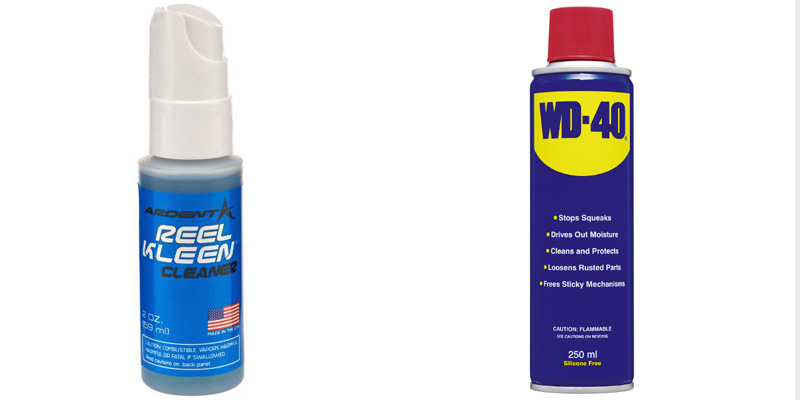 .
.
Oil
Daiwa's reel oiler is excellent, Shimano's reel oil spray is great for reaching difficult areas or where oil needs to be propelled for better penetration, but my favourite remains Quantum's Hot Sauce oil which got discontinued for a while then reintroduced in a new form. I took my time testing this new one and it's as good as it's always been.
 .
.
Grease
Grease is the lifeblood of a reel and it's largely what decides whether the reel will perform to its full potential or quickly degrade with premature wear and/or corrosion. Unfortunately it's almost impossible for fishermen to navigate through all the bad advice and misinformation floating around, much of which sadly comes directly from representatives of major brands who have accounting or sales backgrounds with no relevant manufacturing or engineering experience, therefore I'll take a deeper dive into grease to hopefully make it easier for you to choose what works for you.
Grease is a mixture of two main ingredients; oil and a thickener. Sometimes thickener is referred to as "soap", which is wrong because it can either be soap or nonsoap thickener. There are some additives as well but these two remain the main ingredients. Oils and thickeners come in countless types with various characteristics, but I'll focus on what's important in our particular application. Regarding oils, these can be either mineral or synthetic. Synthetic oils are more desirable as they do a better job and last longer than mineral ones. As for the thickener, its most important trait is the ability to hold as much oil with the smallest rate of bleed as possible. Bleed is a phenomenon where oil separates from thickener over time, and once oil is gone you're left with a depleted thickener that looks good but in reality has little lubrication properties and could harden after a while. Over the years I tested and observed these characteristics to the best of my abilities, and the following are my conclusions:
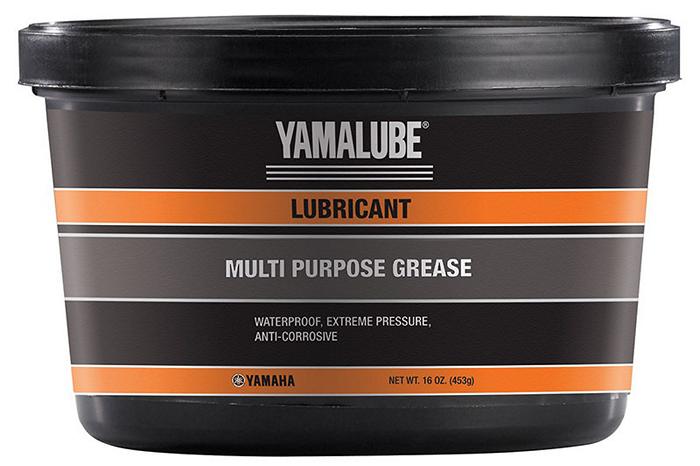
While mineral oil based grease isn't the top option as stated earlier, you might still have a reason to use it, most likely cost since it's generally less expensive than synthetic oil based grease. The best mineral based grease I used is Yamalube Multi-Purpose grease. There is another product called Yamalube Multi-Purpose Marine grease, and while the word "marine" makes it seem like a great match for fishing reels, in practice it has no advantage over the Multi-Purpose (no "Marine") grease for this application and I personally feel that the non-marine one holds oil a bit better.
Moving on to synthetic greases

More than a decade ago I introduced you to certain DuPont Krytox greases as the highest quality option available to end users. Years later, Japanese fishing companies began selling greases that did a similar job so I recommended them as alternatives, but now these have been discontinued so I'm back to Krytox as the premier choice for high performance top reels. Its maker, DuPont, has been spun off and renamed Chemours, so it's now "Chemours Krytox".

The two Krytox greases I recommend are GPL 205, and GPL 225. Use the GPL 205 for protected parts inside the gearbox such as gearing, oscillation mechanism, and inner ball bearings, and use the GPL 225 for areas that are exposed to saltwater such as inside non-sealed line rollers, the external part of the main shaft, and frame ball bearings. The price of Krytox is so obscene that internet providers should require people to opt-in and prove they're over 18 before they can access sites selling it, so it goes without saying that you should only apply it to the actual working surfaces. If you want to brush the inside of the frame or side cover with grease for corrosion protection, use a cheaper grease for that task. Actually covering frames with grease is another good use of low cost mineral oil based greases discussed earlier.
A very important note here. Greases that contain low viscosity oil feel light and produce easy free-spinning, but a sad fact of life is that low viscosity oils bleed (separate from the thickener) faster, reducing the useful life of the grease. On the other hand greases that contain higher viscosity oils see slower bleeding and last longer, but of course that high viscosity creates "heavier" grease that reduces the free-spinning feel of a reel. These Krytox greases will therefore make most reels feel less free-spinning than they were with the light factory grease, but the service life should be longer. It's a trade off that you need to decide whether to accept or not.
If you don't need or can't justify the cost of that premium grease, there are other choices that should also be easier to find since they are branded by fishing companies and your local tackle shop should have them.
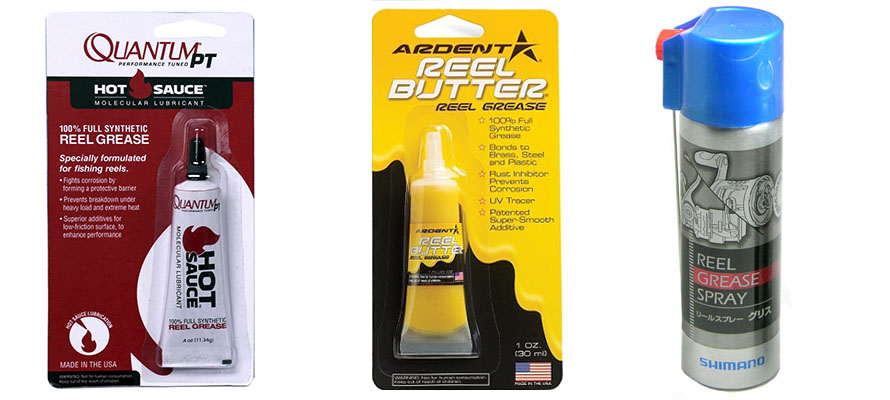
The Quantum Hot Sauce grease remains one of my favourites, followed by Ardent Reel Butter grease as a second choice, and Shimano's spray grease is very useful to shoot grease from a service port or get it into narrow spaces that otherwise are hard to reach.
Drag Grease
Before anything, if you have a 2020 Saltiga DO NOT lube its drag with anything other than the original ATD drag grease. That proprietary formula is an integral part of its drag function and using any other grease or even the UTD grease will alter its performance, unlike the previous generation of Saltiga where it didn't matter much. Unfortunately Daiwa does not sell the ATD drag grease, so you must send your 2020 Saltiga to an official Daiwa service centre if the drag accidentally becomes contaminated and needs servicing.
As for other reels
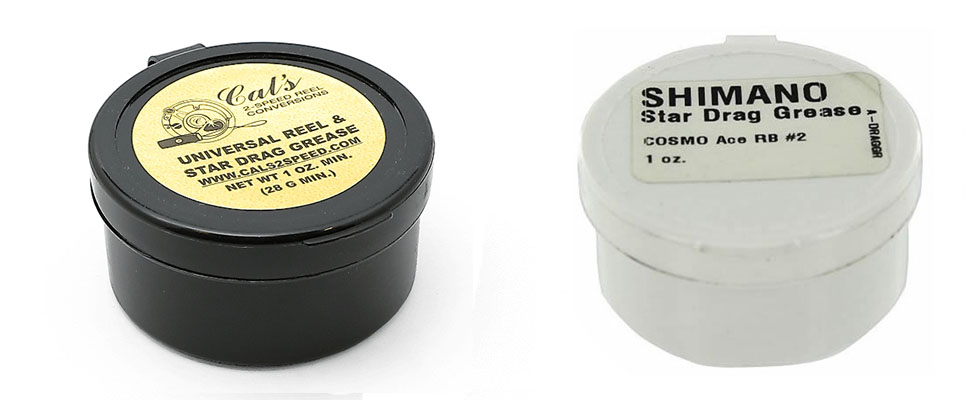
Not much to say here. Cal's drag grease continues to deliver great results, so does Shimano's Star Drag grease. Get whichever is more accessible to you, neither will disappoint.
A quick reminder that only carbon fibre drag washers should be greased. Felt drag washers should only be oiled, and you can use any of the oils discussed earlier for this purpose.
Tools
The past few years saw a proliferation of the usage of hex (Allen) and Torx screws in reels of all ranges, and consequently I've been getting more questions about my choice of tools for these screws.
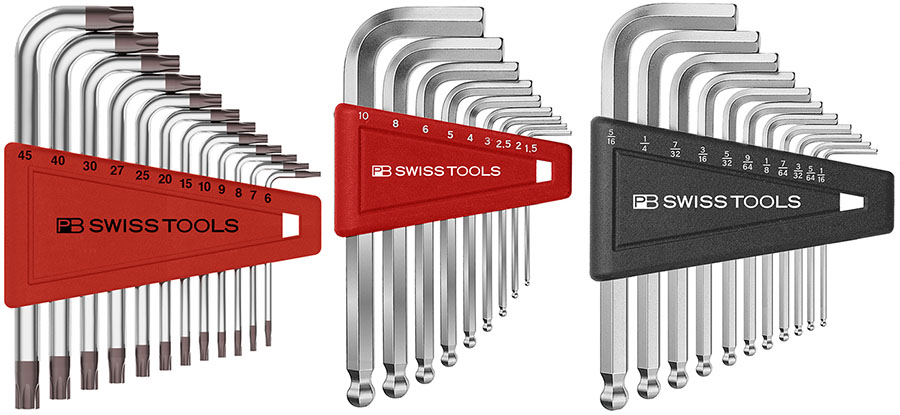
I personally like PB Swiss hex and Torx tools and have found them to be constantly reliable and very precise, things of particular importance when removing a screw that is tightly fitted or one that's stuck due to excessive use of thread locker etc. Equally important is finding the correct fit. Never begin unscrewing a hex or a Torx screw unless you have a tight fit in its head with no play at all, or you'd risk damaging the head and having a major issue on hand. Hex screws are especially notorious for that, and the risk of damage is even higher when dealing with a hex screw whose head was intentionally made shallow to prevent over-tightening. These slippery shallow hex heads are often found in the line roller screw or screws that hold plastic or thin metal parts. Always have two sets of hex wrenches or drivers ready, one in metric (mm) sizes and the other in SAE (inch) sizes, and if you think that one wrench fits well stop and try the comparable one from the other set because you might get an even tighter fit.
DOs & DON'Ts
To finish up this article, I will follow the example of the pamphlets that come with reels bearing silly warnings about things you shouldn't do with the reel, such as hitting someone with it on the head or using the spool to shave your beard. Without further ado, here is my glorious list of things that you should not do with your reel since they might affect its performance-

When I tell you that a reel is "bulletproof", don't go and test that with a .22 LR round. It's called "a figure of speech".

If you want to know whether your reel actually has a hollow bail wire or not, cutting it is not the best course of action. Try asking me instead, since that's often (but not always) less damaging to reels.

And finally, if your reel feels tight don't put it on the stove to "free it up"!

Hope this article will prove useful to you.
Cheers
To support this site and my work, please click here
Alan Hawk
May, 9th, 2014
Updated December 10th, 2020